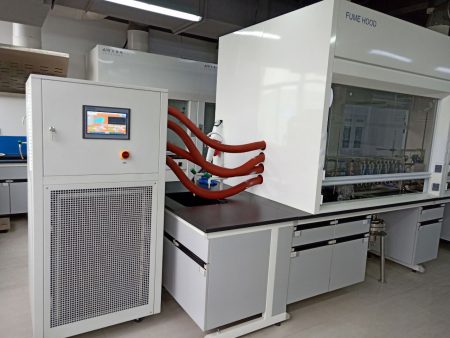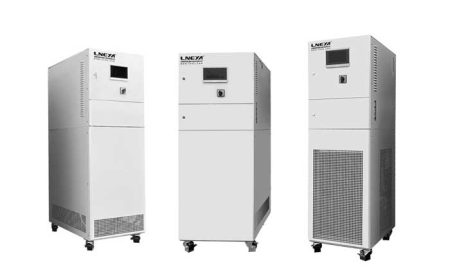Water Glycol Cooling System
Kontaktieren Sie uns noch heute für die perfekte Lösung zur Temperaturkontrolle
A water glycol cooling system is an industrial refrigeration system that uses an antifreeze called ethylene glycol mixed with water to lower the freezing point of the refrigeration system in the application.
Ethylene glycol is a class of organic compounds belonging to the alcohol family. When mixed with water and pumped through the pipes of a cooling system, ethylene glycol slows down freezing. It helps maintain temperature consistency across applications. Some glycol products can also inhibit corrosion and bacterial growth within cooling system piping.
Comparison of Two Ethylene Glycols
There are two varieties of ethylene glycol that should never be mixed together: ethylene glycol and propylene glycol. Both types offer the same relative frost protection rating. Both also help prevent corrosion. Certain grades of both types of glycol can also help prevent the growth of algae and bacteria inside the cooler.
Ethylene glycol
Ethylene glycol is a moderately toxic chemical that has a sweet taste and may be harmful if swallowed. Therefore, it should not be used in drinking water or food processing systems where leakage is possible. Ethylene glycol is more widely used due to its lower purchase price. Industrial applications such as skating rinks and factories that require large amounts of coolant find this to be the most economical option for ethylene glycol.
Propylene glycol
Propylene glycol is less toxic and is considered a food-grade antifreeze. This type of glycol is safer than ethylene and easier to handle. Propylene glycol is commonly used in the food industry or in industrial refrigeration systems where people may come into contact with liquids. Propylene glycol may also be more viscous than ethylene, slightly affecting heat exchange rates even when used at very low temperatures. It is important to note that you should never mix different types or brands of glycols as this can cause condensation of the product and clogging of filters in the refrigeration system, which can cause heat transfer and fluid flow problems.

Mixing water with ethylene glycol in industrial refrigeration systems
Ethylene glycol must be mixed with water to function properly. The type and amount of water to be used are key factors to consider.
Water type
Each glycol chiller has its own set of manufacturer recommendations for the best type of water to use with the system. Although tap water is initially acceptable, long-term use of deionized water is rarely recommended as it may adversely affect certain metals in the cooler. Sometimes manufacturers require coolers to use distilled or reverse osmosis water. The key is to check with the manufacturer about your refrigeration system’s specific needs.
The ratio of water to ethylene glycol
Calculating the appropriate ratio of glycol to water in a cooling system depends on the coldest temperature the glycol solution will reach during operation. If the cooling system is used indoors where there is no chance of freezing, the amount of glycol required will be significantly less than that required for a glycol chiller where outdoor temperatures tend to drop below freezing. Additionally, if the application requires very low temperatures to operate, a glycol mixture similar to that used in outdoor systems should be used. In cooling systems, this temperature is typically the saturated suction temperature in the evaporator, and this temperature is typically 10°F below the cooler set point temperature. It is important to use the proper ratio of glycol and water in your cooling system.
Wir bieten die Entwicklung und Herstellung kompletter Temperaturkontrollsysteme an. Von Standardmodellen bis zu kompletten kundenspezifischen Produkten bis hin zu 900 Tonnen. Wir haben uns auf den Kundenservice spezialisiert und sind bestrebt, jedem Kunden zu helfen, das optimale Temperaturkontrollsystem für seinen spezifischen Bedarf zu finden.
Wir bieten maßgeschneiderte Lösungen, die nicht dem Standard entsprechen. Es sind sowohl einzelne Kühlaggregate als auch kombinierte Kühl- und Heizaggregate erhältlich.
E-Mail: info@lneya.com WeChat ID: +8615251628237 WhatsApp: +86 17851209193

Rückkühler / Umwälzkühler
Die Kältemaschine kann in verschiedenen Industrien und Labors eingesetzt werden und unterstützt kundenspezifische Designs.
| Temperaturbereich | Serie -25°C ~ +30°C | -45°C ~ +30°C Reihe | Serie -60°C ~ -20°C | Serie -80°C ~ -20°C | Serie -120°C ~ -70°C | ||||
| Kühlleistung | 0,8 ~ 30kW | 0,75 ~ 12kW | 0,4 ~ 6kW | 0,2 ~ 6kW | 0,3 ~ 5kW | ||||
| Hinweis: Jeder Temperaturbereich von -150℃ ~ +350℃ und jede Kühlleistung kann angepasst werden | |||||||||
 Kaltwassersätze / Kleinkaltwassersätze
Kaltwassersätze / Kleinkaltwassersätze
Die Kältemaschine kann in verschiedenen Industrien und Labors eingesetzt werden und unterstützt kundenspezifische Designs.
| Temperaturbereich | -18°C ~ +30°C | +5°C ~ +35°C Reihe | |||||||
| Kühlleistung | 0,35 ~ 0,9kW | 1,8 ~ 50kW | |||||||
| Hinweis: Jeder Temperaturbereich von -150℃ ~ +350℃ und jede Kühlleistung kann angepasst werden | |||||||||

Niedertemperatur-Kühlgeräte
Wir haben uns auf die Herstellung von Niedertemperaturkältemaschinen mit einem Temperaturregelbereich von bis zu -150°C spezialisiert, die den Kühlbedarf verschiedener Branchen decken.
| Temperaturbereich | Serie -25°C ~ -5°C | Serie -45°C ~ -10°C | Serie -60°C ~ -10°C | Serie -80°C ~ -30°C | Serie -110°C ~ -50°C | Serie -150°C ~ -110°C | |||
| Kühlleistung | 12 ~ 360kW | 6 ~ 180kW | 6 ~ 180kW | 4 ~ 180kW | 2 ~ 120kW | 2,5 ~ 11kW | |||
| Hinweis: Jeder Temperaturbereich von -150℃ ~ +350℃ und jede Kühlleistung kann angepasst werden | |||||||||

Hochtemperatur-Kühlgeräte
Die Kältemaschine kann in verschiedenen Industrien und Labors eingesetzt werden und unterstützt kundenspezifische Designs.
| Temperaturbereich | +5°C ~ +40°C | -25°C ~ +40°C | -45°C ~ +40°C | -80°C ~ +80°C | -100°C ~ +80°C | ||||
| Kühlleistung | 6 ~ 40kW | 2 ~ 15kW | 1 ~ 8kW | 0,6 ~ 3kW | 1,5 ~ 3kW | ||||
| Hinweis: Jeder Temperaturbereich von -150℃ ~ +350℃ und jede Kühlleistung kann angepasst werden | |||||||||
Kühlen und Heizen Kaltwassersätze

Kühlen und Heizen Kaltwassersätze
Temperaturregelbereich: -120°C bis +350°C
Kühl- und Heizungsthermostate, die in verschiedenen Industriezweigen weit verbreitet sind.
| Temperaturbereich | Serie -10 ~ +150°C | Serie -25 ~ +200°C | Serie -25 ~ +300°C | Serie -45 ~ +250°C | Serie -45 ~ +300°C | Serie -60 ~ +250°C | Serie -60 ~ +300°C | Serie -70 ~ +250°C | Serie -80 ~ +250°C | Serie -90 ~ +250°C | Serie -100 ~ +100°C | ||
| Kühlleistung | 1,5 ~ 15kW | 1 ~ 200kW | 1 ~ 200kW | 0,45 ~ 200kW | 0,9 ~ 25kW | 0,25 ~ 60kW | 0,75 ~ 25kW | 0,4 ~ 15kW | 0,3 ~ 80kW | 0,2 ~ 80kW | 0,45 ~ 80kW | ||
| Hinweis: Jeder Temperaturbereich von -150℃ ~ +350℃ und jede Kühlleistung kann angepasst werden | |||||||||||||

Kühlgeräte mit Rücklaufheizung
Temperaturregelbereich: -45°C bis +250°C
| Temperaturbereich | Serie -25°C ~ +200°C | Serie -45°C ~ +250°C | |||||||
| Kühlleistung | 1 ~ 15kW | 0,25 ~ 15kW | |||||||
| Hinweis: Jeder Temperaturbereich von -150℃ ~ +350℃ und jede Kühlleistung kann angepasst werden | |||||||||
 LNEYA
LNEYA
 简体中文
简体中文


















































































